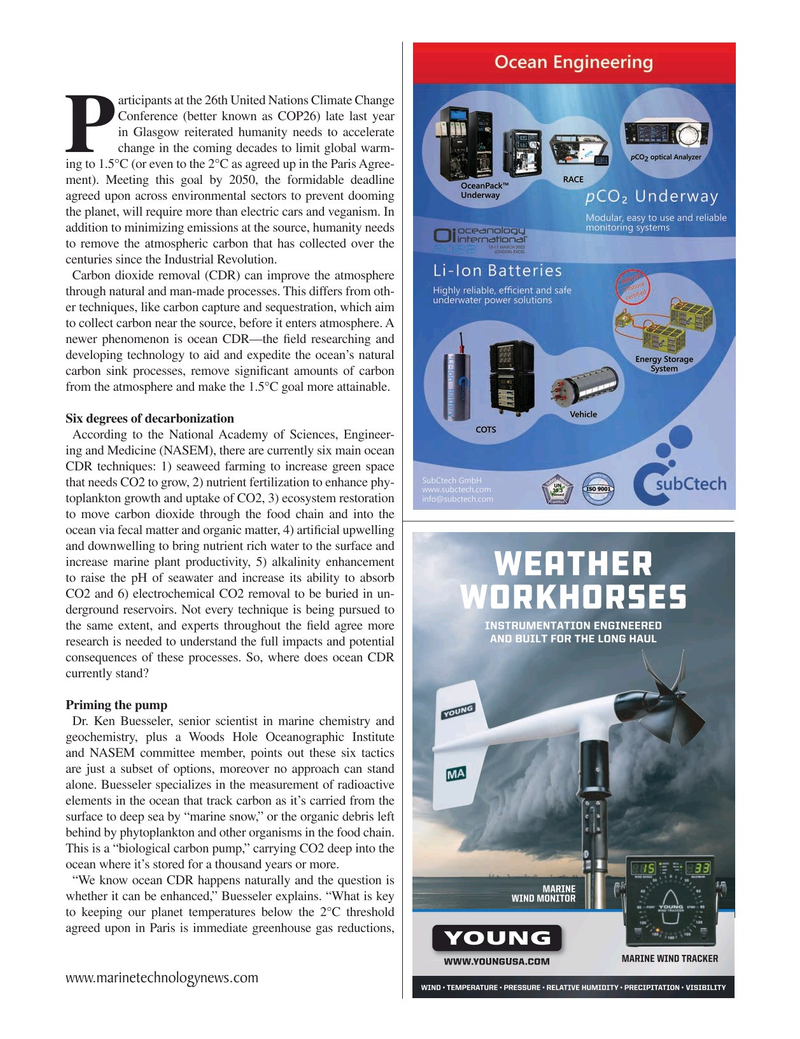
Page 45: of Marine Technology Magazine (March 2022)
Read this page in Pdf, Flash or Html5 edition of March 2022 Marine Technology Magazine
articipants at the 26th United Nations Climate Change
Conference (better known as COP26) late last year in Glasgow reiterated humanity needs to accelerate change in the coming decades to limit global warm-
P ing to 1.5°C (or even to the 2°C as agreed up in the Paris Agree- ment). Meeting this goal by 2050, the formidable deadline agreed upon across environmental sectors to prevent dooming the planet, will require more than electric cars and veganism. In addition to minimizing emissions at the source, humanity needs to remove the atmospheric carbon that has collected over the centuries since the Industrial Revolution.
Carbon dioxide removal (CDR) can improve the atmosphere through natural and man-made processes. This differs from oth- er techniques, like carbon capture and sequestration, which aim to collect carbon near the source, before it enters atmosphere. A newer phenomenon is ocean CDR—the ? eld researching and developing technology to aid and expedite the ocean’s natural carbon sink processes, remove signi? cant amounts of carbon from the atmosphere and make the 1.5°C goal more attainable.
Six degrees of decarbonization
According to the National Academy of Sciences, Engineer- ing and Medicine (NASEM), there are currently six main ocean
CDR techniques: 1) seaweed farming to increase green space that needs CO2 to grow, 2) nutrient fertilization to enhance phy- toplankton growth and uptake of CO2, 3) ecosystem restoration to move carbon dioxide through the food chain and into the ocean via fecal matter and organic matter, 4) arti? cial upwelling and downwelling to bring nutrient rich water to the surface and increase marine plant productivity, 5) alkalinity enhancement to raise the pH of seawater and increase its ability to absorb
CO2 and 6) electrochemical CO2 removal to be buried in un- derground reservoirs. Not every technique is being pursued to the same extent, and experts throughout the ? eld agree more research is needed to understand the full impacts and potential consequences of these processes. So, where does ocean CDR currently stand?
Priming the pump
Dr. Ken Buesseler, senior scientist in marine chemistry and geochemistry, plus a Woods Hole Oceanographic Institute and NASEM committee member, points out these six tactics are just a subset of options, moreover no approach can stand alone. Buesseler specializes in the measurement of radioactive elements in the ocean that track carbon as it’s carried from the surface to deep sea by “marine snow,” or the organic debris left behind by phytoplankton and other organisms in the food chain.
This is a “biological carbon pump,” carrying CO2 deep into the ocean where it’s stored for a thousand years or more.
“We know ocean CDR happens naturally and the question is whether it can be enhanced,” Buesseler explains. “What is key to keeping our planet temperatures below the 2°C threshold agreed upon in Paris is immediate greenhouse gas reductions, www.marinetechnologynews.com
MTR #3 (34-49).indd 45 2/25/2022 11:48:35 AM

 44
44

 46
46
